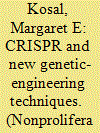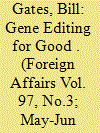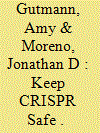|
|
|
Sort Order |
|
|
|
Items / Page
|
|
|
|
|
|
|
| Srl | Item |
| 1 |
ID:
182960


|
|
|
|
|
| Summary/Abstract |
This article explores the potential for new biotechnologically enabled weapons to compete with nuclear weapons in the context of strategic stability, assesses how such new technologies may affect assumptions in traditional strategic-stability models when applied to such scenarios, and how changing capabilities and adversaries may shape approaches to nonproliferation, verification, and monitoring. Among the most recent additions to the genome-editing arsenal is CRISPR (clustered regularly interspaced short palindromic repeats), a bacteria-derived system that is among the simplest genome-editing tools. The CRISPR-Cas9 system—and emerging variants of the system—enables unprecedented control and ease when editing the genome. With parallels to remote “command and control” of the genome, this aspect makes the technology different from earlier gene-editing methods. This article furthers the scholarly work on the biosecurity implications of CRISPR, gene editing, and broader issues of biotechnology by addressing these emerging life-science technologies in the context of nuclear strategic stability and implications for balance of power, nonproliferation, and international security.
|
|
|
|
|
|
|
|
|
|
|
|
|
|
|
|
| 2 |
ID:
182959


|
|
|
|
|
| Summary/Abstract |
The gene-editing technique CRISPR—clustered regularly interspaced short palindromic repeats—is often depicted as a security threat because it could theoretically allow scientists or amateurs to edit the genome of a variety of organisms and potentially cause harm to humans, plants, and animals. The recent use of CRISPR by Chinese scientist He Jiankui to edit the genome of viable embryos, which resulted in the birth of twin girls, has exacerbated those fears. This article reviews the timeline of the CRISPR-babies experiment, highlights the challenges that contributed to the experiment's failure, and evaluates the risks of CRISPR's use for malevolent purposes. It concludes that although the potential for abuse is great, the technical obstacles are still too significant to allow successful modification that would threaten security.
|
|
|
|
|
|
|
|
|
|
|
|
|
|
|
|
| 3 |
ID:
158876


|
|
|
|
|
| Summary/Abstract |
Today, more people are living healthy, productive lives than ever before. This good news may come as a surprise, but there is plenty of evidence for it. Since the early 1990s, global child mortality has been cut in half [1]. There have been massive reductions in cases of tuberculosis, malaria, and HIV/AIDS [2]. The incidence of polio has decreased by 99 percent, bringing the world to the verge of eradicating a major infectious disease, a feat humanity has accomplished only once before, with smallpox. The proportion of the world’s population in extreme poverty, defined by the World Bank as living on less than $1.90 per day, has fallen from 35 percent to about 11 percent.
|
|
|
|
|
|
|
|
|
|
|
|
|
|
|
|
| 4 |
ID:
158878


|
|
|
|
|
| Summary/Abstract |
The possibility of rewriting the genome of an organism, or even of an entire species, has long been the stuff of science fiction. But with the development of CRISPR [1] (which stands for “clustered regularly interspaced short palindromic repeats”), a method for editing DNA [2] far more precisely and efficiently than was possible with older technologies, fiction has edged closer to reality. CRISPR exploits an ancient system that allows bacteria to acquire immunity from viruses. It uses an enzyme called Cas9 to cut strands of DNA at precisely targeted locations, allowing researchers to insert new genetic material into the gap.
|
|
|
|
|
|
|
|
|
|
|
|
|
|
|
|
|
|
|
|
|